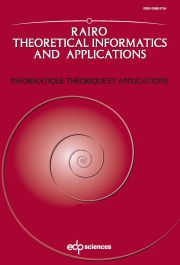Crossref Citations
This article has been cited by the following publications. This list is generated based on data provided by Crossref.
Berstel, Jean
2007.
Algebraic Informatics.
Vol. 4728,
Issue. ,
p.
23.
Cassaigne, J.
and
Frid, A.E.
2007.
On the arithmetical complexity of Sturmian words.
Theoretical Computer Science,
Vol. 380,
Issue. 3,
p.
304.
Мучник, Андрей Альбертович
Muchnik, Andrei Albertovich
Притыкин, Юрий Львович
Pritykin, Yurii L'vovich
Семeнов, Алексей Львович
and
Semenov, Aleksei L'vovich
2009.
Последовательности, близкие к периодическим.
Успехи математических наук,
Vol. 64,
Issue. 5,
p.
21.
KAMAE, TETURO
and
SALIMOV, PAVEL V.
2011.
On maximal pattern complexity of some automatic words.
Ergodic Theory and Dynamical Systems,
Vol. 31,
Issue. 5,
p.
1463.
2014.
Formal Languages, Automata and Numeration Systems 2.
p.
193.
2014.
Formal Languages, Automata and Numeration Systems 1.
p.
257.
Parshina, Olga G.
2017.
Combinatorics on Words.
Vol. 10432,
Issue. ,
p.
121.
Špitalský, Vladimír
2018.
Recurrence Quantification Analysis of the Period-Doubling Sequence.
International Journal of Bifurcation and Chaos,
Vol. 28,
Issue. 14,
p.
1850181.
Poláková, Miroslava
2020.
Formulas for complexity, invariant measure and RQA characteristics of the period-doubling subshift.
Communications in Nonlinear Science and Numerical Simulation,
Vol. 80,
Issue. ,
p.
104996.
Aedo, Ibai
Grimm, Uwe
Nagai, Yasushi
and
Staynova, Petra
2022.
Monochromatic arithmetic progressions in binary Thue–Morse-like words.
Theoretical Computer Science,
Vol. 934,
Issue. ,
p.
65.
Sobolewski, Bartosz
2024.
On monochromatic arithmetic progressions in binary words associated with pattern sequences.
Theoretical Computer Science,
Vol. 1018,
Issue. ,
p.
114815.
Aedo, Ibai
Grimm, Uwe
Mañibo, Neil
Nagai, Yasushi
and
Staynova, Petra
2024.
Monochromatic arithmetic progressions in automatic sequences with group structure.
Journal of Combinatorial Theory, Series A,
Vol. 203,
Issue. ,
p.
105831.
Kirova, Valeria Orlanovna
and
Godunov, Igor Valentinovich
2024.
On the complexity functions of Sturmian words.
Chebyshevskii Sbornik,
Vol. 24,
Issue. 4,
p.
63.
Puzynina, Svetlana
2025.
Machines, Computations, and Universality.
Vol. 15270,
Issue. ,
p.
1.


